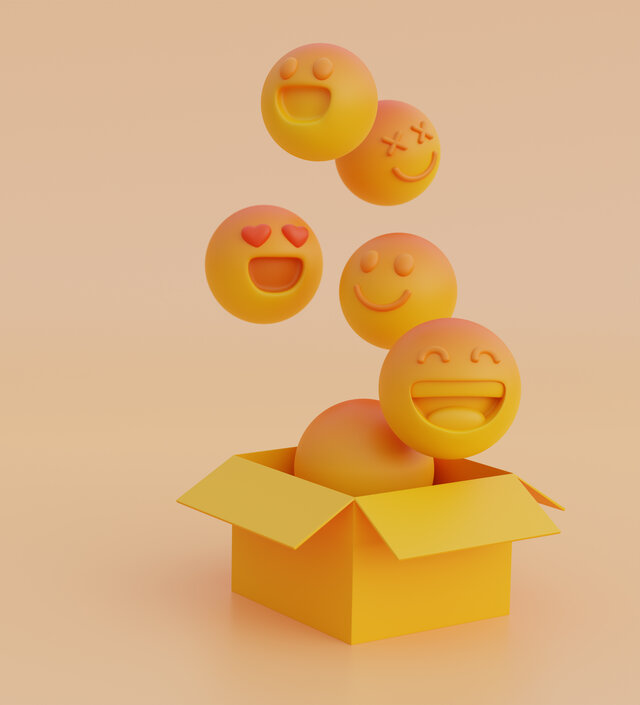What this post is about
- Emojis and their origin
- Emojis and their effect
- Emojis in customer communication
- The 10 most popular emojis in customer service
With their introduction, emojis have fundamentally changed the way we communicate – so much so that they even have their own unofficial holiday. Since 2014, World Emoji Day has been celebrated annually on July 17. This day was initiated by Jeremy Burge, the founder of Emojipedia, an online reference for emojis. The choice of date was no coincidence: the calendar emoji, as found on Apple iPhones or Android devices, shows exactly July 17.
What are emojis and where do they come from?
The term “emoji” comes from Japanese and literally means “picture character” or “pictogram”. This term illustrates the function of emojis as visual symbols that complement and enrich text-based communication. They were first developed in Japan in the late 1990s, with Japanese designer Shigetaka Kurita being considered the “father of emojis”. He designed the first 176 emojis for the Japanese mobile phone provider NTT DoCoMo.
The original emojis were simple and pixelated, but laid the foundation for today's emoji culture. With the rise of smartphones and social media in the 2000s, emojis became popular internationally. In 2010, they were officially included in the Unicode standard, enabling their use on different platforms and devices.
How emojis influence communication and why we love them
Emojis are more than just colorful pictures. They allow us to quickly and effectively convey emotions and moods. In a world where text messages can often be misunderstood, emojis provide a visual context that makes the meaning of a message clearer. Here are some aspects of how emojis influence our communication:
-
Emotional Expressiveness: An emoji can convey feelings in messages that are difficult to put into words. A simple "😊" can instantly make a message appear friendlier and more inviting.
-
Connection: Many emojis are universally understood and create a personal connection in digital communication. A "👋" can, for example, convey a warm greeting that is understood across language barriers.
-
Creativity and Fun: Emojis bring color and creativity to our messages. They make typing texts less monotonous and more enjoyable. Entire messages can be composed of emojis, such as "🎉🎂🥳" for "Happy Birthday!" or "🏖️🌞🍹" for "vacation vibes."
-
Efficiency: They are easy to use and understand. Emojis can summarize complex messages in a single symbol. A "👍" can express agreement or support, while a "❗" signals urgency.
Emojis in customer communication
Emojis can work wonders in customer service. They make communication with customers more personal and accessible and help to build trust and convey the tone of a message more clearly. Additionally, short responses can be enhanced with emojis, making customer service faster and more effective.
In general, the use of emojis depends on the situation, the target group and the channel. In customer service in particular, the situations are very different and every contact is unique.
So when should emojis be avoided?
Formal matters: Emojis have no place in formal communication and can even lead to misunderstandings. Is a contract effectively concluded with a 👍 emoji? Such questions show the limits of the use of emojis.
Misleading symbols: When the meaning of an emoji is not clear and misunderstandings can arise. The smiley 🙂 is currently a subject of much debate. Is it friendly, ironic, or passive-aggressive? Such ambiguities can impair communication.
Excessive use: Too many emojis can come across as unprofessional and dilute the message. Such sentences quickly turn into a guessing game: "Hello 👋, we have received your 📧 and will 📲 you soon. Please give us some ⏳."
The 10 most popular emojis in customer service
😊 The all-rounder among emojis. Perfect for expressing satisfaction or simply friendliness.
👍 The classic for approval and confirmation. Also known as the “looks good” emoji.
👋 The friendly hand wave as a digital version of a polite “hello” or “goodbye”. It can also mean “I'm here to help”.
🙏 For moments when a simple “Thank you for shedding light on the most complex (but also the most tedious) cases!” is not enough.
💬 The universal symbol for communication and conversation. Perfect for inviting the customer to engage in dialog.
📞 For when a personal conversation is necessary. The “Let's talk on the phone” emoji.
💡 For a flash of inspiration or a brilliant idea. The solution is already on its way.
😮 Oops! Something's gone wrong. The agent is at least as surprised as the customer.
⭐ The “A plus with a star” for first-class support. This emoji is the favorite way to show appreciation for a helpful agent.
Conclusion
Emojis are small but powerful tools that can significantly improve customer communication. With a touch of humor and the right application, they promote more human and efficient communication. These small symbols with a big impact have rightly earned their own international holiday. 🌍🎉😊

